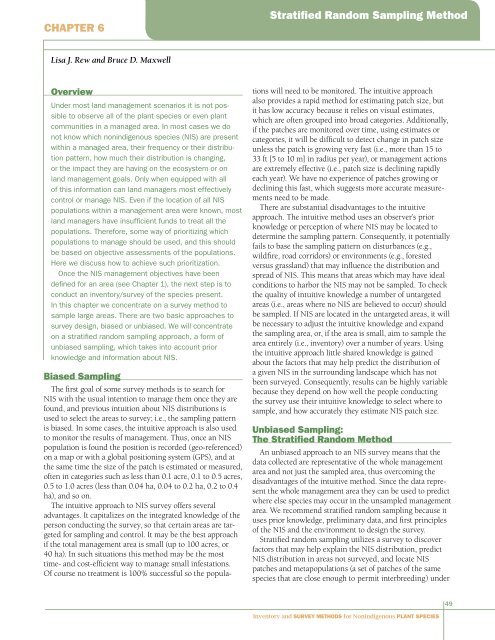Inventory and Survey Methods for Nonindigenous Plant Species (PDF)
Inventory and Survey Methods for Nonindigenous Plant Species (PDF)
Inventory and Survey Methods for Nonindigenous Plant Species (PDF)
- No tags were found...
Create successful ePaper yourself
Turn your PDF publications into a flip-book with our unique Google optimized e-Paper software.
Chapter 6Stratified R<strong>and</strong>om Sampling MethodLisa J. Rew <strong>and</strong> Bruce D. MaxwellOverviewUnder most l<strong>and</strong> management scenarios it is not possibleto observe all of the plant species or even plantcommunities in a managed area. In most cases we donot know which nonindigenous species (NIS) are presentwithin a managed area, their frequency or their distributionpattern, how much their distribution is changing,or the impact they are having on the ecosystem or onl<strong>and</strong> management goals. Only when equipped with allof this in<strong>for</strong>mation can l<strong>and</strong> managers most effectivelycontrol or manage NIS. Even if the location of all NISpopulations within a management area were known, mostl<strong>and</strong> managers have insufficient funds to treat all thepopulations. There<strong>for</strong>e, some way of prioritizing whichpopulations to manage should be used, <strong>and</strong> this shouldbe based on objective assessments of the populations.Here we discuss how to achieve such prioritization.Once the NIS management objectives have beendefined <strong>for</strong> an area (see Chapter 1), the next step is toconduct an inventory/survey of the species present.In this chapter we concentrate on a survey method tosample large areas. There are two basic approaches tosurvey design, biased or unbiased. We will concentrateon a stratified r<strong>and</strong>om sampling approach, a <strong>for</strong>m ofunbiased sampling, which takes into account priorknowledge <strong>and</strong> in<strong>for</strong>mation about NIS.Biased SamplingThe first goal of some survey methods is to search <strong>for</strong>NIS with the usual intention to manage them once they arefound, <strong>and</strong> previous intuition about NIS distributions isused to select the areas to survey; i.e., the sampling patternis biased. In some cases, the intuitive approach is also usedto monitor the results of management. Thus, once an NISpopulation is found the position is recorded (geo-referenced)on a map or with a global positioning system (GPS), <strong>and</strong> atthe same time the size of the patch is estimated or measured,often in categories such as less than 0.1 acre, 0.1 to 0.5 acres,0.5 to 1.0 acres (less than 0.04 ha, 0.04 to 0.2 ha, 0.2 to 0.4ha), <strong>and</strong> so on.The intuitive approach to NIS survey offers severaladvantages. It capitalizes on the integrated knowledge of theperson conducting the survey, so that certain areas are targeted<strong>for</strong> sampling <strong>and</strong> control. It may be the best approachif the total management area is small (up to 100 acres, or40 ha). In such situations this method may be the mosttime- <strong>and</strong> cost-efficient way to manage small infestations.Of course no treatment is 100% successful so the populationswill need to be monitored. The intuitive approachalso provides a rapid method <strong>for</strong> estimating patch size, butit has low accuracy because it relies on visual estimates,which are often grouped into broad categories. Additionally,if the patches are monitored over time, using estimates orcategories, it will be difficult to detect change in patch sizeunless the patch is growing very fast (i.e., more than 15 to33 ft [5 to 10 m] in radius per year), or management actionsare extremely effective (i.e., patch size is declining rapidlyeach year). We have no experience of patches growing ordeclining this fast, which suggests more accurate measurementsneed to be made.There are substantial disadvantages to the intuitiveapproach. The intuitive method uses an observer’s priorknowledge or perception of where NIS may be located todetermine the sampling pattern. Consequently, it potentiallyfails to base the sampling pattern on disturbances (e.g.,wildfire, road corridors) or environments (e.g., <strong>for</strong>estedversus grassl<strong>and</strong>) that may influence the distribution <strong>and</strong>spread of NIS. This means that areas which may have idealconditions to harbor the NIS may not be sampled. To checkthe quality of intuitive knowledge a number of untargetedareas (i.e., areas where no NIS are believed to occur) shouldbe sampled. If NIS are located in the untargeted areas, it willbe necessary to adjust the intuitive knowledge <strong>and</strong> exp<strong>and</strong>the sampling area, or, if the area is small, aim to sample thearea entirely (i.e., inventory) over a number of years. Usingthe intuitive approach little shared knowledge is gainedabout the factors that may help predict the distribution ofa given NIS in the surrounding l<strong>and</strong>scape which has notbeen surveyed. Consequently, results can be highly variablebecause they depend on how well the people conductingthe survey use their intuitive knowledge to select where tosample, <strong>and</strong> how accurately they estimate NIS patch size.Unbiased Sampling:The Stratified R<strong>and</strong>om MethodAn unbiased approach to an NIS survey means that thedata collected are representative of the whole managementarea <strong>and</strong> not just the sampled area, thus overcoming thedisadvantages of the intuitive method. Since the data representthe whole management area they can be used to predictwhere else species may occur in the unsampled managementarea. We recommend stratified r<strong>and</strong>om sampling because ituses prior knowledge, preliminary data, <strong>and</strong> first principlesof the NIS <strong>and</strong> the environment to design the survey.Stratified r<strong>and</strong>om sampling utilizes a survey to discoverfactors that may help explain the NIS distribution, predictNIS distribution in areas not surveyed, <strong>and</strong> locate NISpatches <strong>and</strong> metapopulations (a set of patches of the samespecies that are close enough to permit interbreeding) under49<strong>Inventory</strong> <strong>and</strong> <strong>Survey</strong> <strong>Methods</strong> <strong>for</strong> <strong>Nonindigenous</strong> <strong>Plant</strong> <strong>Species</strong>
















